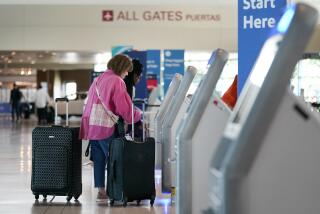Corporations Get Serious About Trimming Travel Costs
- Share via
You don’t have to sit in the no-frills section of a Trailways bus to save travel costs these days. There are other ways.
Irvine-based Fluor Corp., for example, has created its own in-house travel agency to help manage higher travel expenses. Staffed with two company employees and three representatives of Santa Ana-based Associated Travel Management, the department pores over detailed reports on travel by employees of the big engineering and construction firm.
“We can see where the volume is, so we can negotiate better rates” on air fares and hotels, said Pat Kuypers, Fluor’s travel services supervisor.
Fluor’s program is just one example of how Orange County companies are responding to escalating travel expenses. Those efforts range from designating a single person to handle all travel arrangements to using computer software to keep track of each and every plane flight.
Cost-cutting measures are important because travel costs have skyrocketed. The major U.S. airlines raised cheap fares often used by corporate travelers twice last year--in some cases by as much as 85%. The costs of lodging, car rentals and meals are spiraling as well.
U.S. corporations spent an estimated $95 billion on travel and entertainment last year, according to the 1988-1989 American Express Survey of Business Travel Management. At the current rate, the survey says, travel costs will be “astronomically high” by the end of this century.
The answer, for more and more companies, is to cast a sharp eye on travel costs. Travel and entertainment is the third-largest controllable expense for many companies, American Express reported, trailing only salaries and data processing.
According to industry experts, travel costs can be trimmed by searching for the best rates, bargaining for bulk discounts, keeping track of how much is spent and finding a savvy travel agent who knows how to meet a company’s needs.
With the right money-saving tactics, travel experts say, corporations can save up to 50% on the price of coach flights and 5% to 30% on the cost of lodging.
Until recently, controlling travel costs was not one of corporate America’s top concerns.
“There was no ability to negotiate air fares or hotel rates, no information available . . . to tell companies how many trips (employees) took to New York, where they stayed or how much they paid,” said Bruce Rognlien, chairman of Associated Travel Management, which books $100 million a year in air travel. “It didn’t matter because the price was the price was the price.”
Deregulation of the airline industry changed all that. “Before then, prices were government-regulated, so everybody charged the same in order to keep quality consistent,” said Scott Shadrick, an owner and executive vice president of Irvine-based Sundance Travel.
Deregulation brought price competition. It also brought a pricing morass.
There are anywhere from 25,000 to 100,000 air fare changes on the average day, according to travel experts. Tickets to a single destination can have up to 150 different fares. And in the same coach cabin on a plane, passengers may have paid as many as 10 to 20 different fares, depending on when tickets were purchased, how long the traveler is staying and when he or she plans to return, Shadrick said.
The most basic way of attacking the problem is to have a corporate travel policy. These policies typically include restrictions on who can make travel arrangements, what fares are allowed, what hotels can be stayed in and what cars can be rented.
“It’s one way we have some consistency in keeping a lid on costs,” said Kay Carpenter, a spokeswoman for Beatrice/Hunt-Wesson in Fullerton. “If one secretary went outside to another travel agency and the secretary down the hall did the same thing, there would be no way to police that.”
Once a policy is in place, many companies help enforce it by using one centralized system--either in-house or an outside agency--to make travel arrangements.
“Once travel is centralized . . . an automation system will (automatically) allow or disallow certain types of travel, depending on the corporation’s policy,” Shadrick said. The centralized agency “will know the parameters of what’s permissible and what isn’t.”
Keeping track of what is spent to save costs is one reason that ICN Pharmaceuticals Inc., for example, has an in-house travel manager who makes virtual door-to-door travel arrangements for travel by employees of the Costa Mesa company.
An ICN secretary can put in an executive’s request to Milena Vasich, the travel manager, and get back airline tickets, a seat assignment, hotel reservations, rental car reservations, an itinerary, a limousine and meeting rooms.
With airline travel bills of about $1 million last year, keeping tabs on travel costs is important for ICN.
And the single-agent system “is the only way to save costs,” said Vasich, who estimates she books an average of almost 100 tickets each week.
“Agencies are good about getting the lowest fares, but secretaries don’t always ask,” Vasich said. “I’ll find the cheapest fare for that particular time between the two cities, know who is going, what class of service and so forth.”
Many airlines will gladly negotiate discounts of 5% to 50% if a group of at least 10 travelers gives advance notice and the travelers are all headed to the same destination at the same time, several local travel agents said.
What’s trickier is negotiating discounts on air fares for business people who make repeated trips to the same city, but who travel alone or in very small groups. Yet it can be done.
More common are negotiated bulk discounts on hotel stays.
Hotel rates “are totally negotiable,” said Associated Travel’s Rognlien. “Each hotel is its own profit center and makes its own deal.”
Because many of the larger travel agencies handle so many corporate clients, they can offer all of their customers a preferred rate that can be up to 30% lower than a hotel’s usual business-traveler rate.
At the New York Hilton, for example, Rognlien said, the rack rate (the basic rate offered to tourists) is $225 for a single per night. The corporate rate for many corporate travelers is $170. But the negotiated rate for business travelers is $150 per night.
Moreover, companies can do their own negotiating for hotel rates, as well as car rentals.
At ICN, Vasich tells how the pharmaceutical company has arranged discounts ranging from 10% to 30% with hotels in Orange County and “all over the world.”
One thing essential to negotiating any discounts--fares, hotels or car rentals--is good data documenting a lot of corporate travel, according to travel agents.
To help keep track, many companies are relying on their travel agents, credit accounts or their own personnel to keep close track of what is spent on travel.
Allergan Inc., for instance, is experimenting with Capture, a software program intended to help companies track each category of travel and entertainment expenses.
The program “would have an on-line system that allows you to determine on a pre- and post-travel budget whether you’ve stayed within budget,” said Bob Dorman of Hickory/Cal-Mart Travel Service Inc., an Irvine travel company with annual sales of about $30 million.
But saving money isn’t always cheap. The Capture system costs from $50,000 to $100,000, depending on the company’s requirements.
Even so, according to Dorman, “it gives a corporation a tool to effectively manage” travel costs.
HOW AIR FARES HAVE RISEN
Approximate round-trip coach fares between Orange County and selected cities. Fares are for the average business traveler who flies on a weekday, doesn’t reserve in advance and doesn’t stay over a Saturday night.
Year Ago Now San Francisco $218 $296 New York 700 934 Chicago 400 700 Washington 700 900
Source: travel industry.
More to Read
Inside the business of entertainment
The Wide Shot brings you news, analysis and insights on everything from streaming wars to production — and what it all means for the future.
You may occasionally receive promotional content from the Los Angeles Times.










